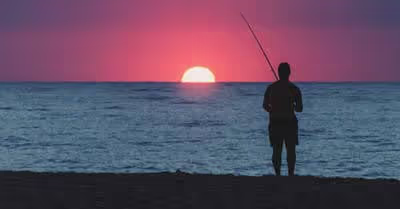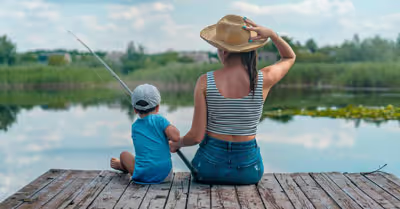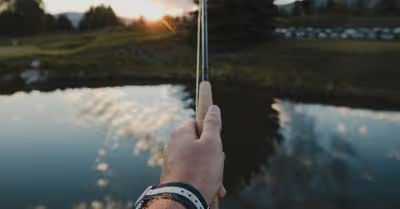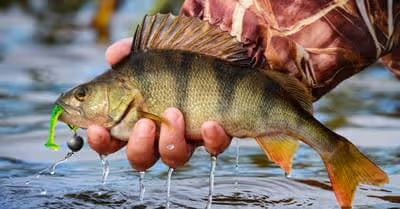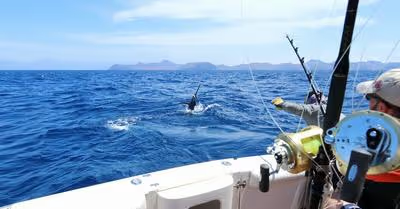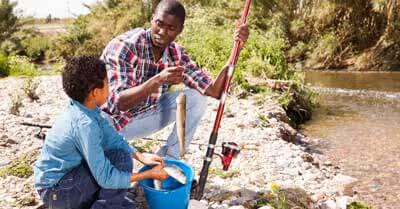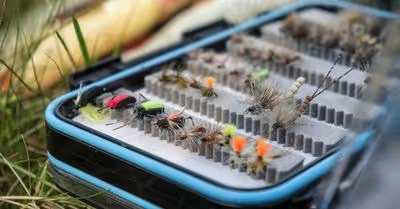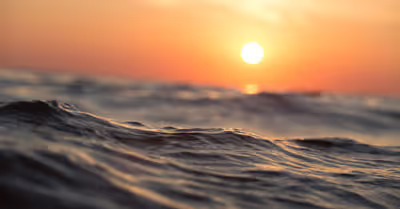Table of Contents
Equipment for River Fishing
Before considering fishing in the river, you should first gather the appropriate equipment you'll need for the activity. They include the following.
Rod & Reels
A fishing reel and rod are of significant importance for successful river fishing. In this case, a lighter fishing rod is ideal since you can hold it for long periods without tiring. Additionally, detecting a bite with such a rod is easier.
Hooks
When fishing in the river, it's advisable to use wide hooks that will be trapped in the fish's mouth. Small hooks can only be caught deep in the fish's throat, and this may reduce the chances of succeeding in river fishing.
Lures & Bait
In addition, you'll; also require lures to draw fish to your bait. The bait is then fixed on the hook to catch the fish.
Shiny and lures with brighter colors are the best for attracting the fish. Still, you can use lures that are similar to the typical prey instead of the bright colored ones.
When choosing the right bait for river fishing, research to identify the favorite prey for fish at the river, you'll be fishing. Baits could be anything from plastic bait, leeches, or crickets.
Nightcrawlers flies, and salmon eggs also make excellent baits, but worms offer exceptional success.
Line Cutter
A line cutter is perfect for cutting logs or tree branches in case your line gets caught in any of these. The cutter will allow you to free the line promptly.
Weights
Weights enable your bait to remain underwater. They also allow you to create extra casting distance. If you're a beginner in river fishing, go for split shot weights. They are easy to install.
Polarized Sunglasses
When shopping for river fishing sunglasses, ensure they are polarized. Polarization helps to eliminate glare from the water. Besides, you'll be able to see better in the water. If the lenses aren't polarized, you'll be making guesses on what is in the water.
Sinker
Since rivers are flowing, the bait and line will most probably float on the water. A sinker will push the bait to the bottom of the river, where fish are most likely to be hiding.
River Fishing Techniques
If you want to succeed in river fishing, it's essential to get acquainted with some of the standard techniques used in rivers. They include:
Downstream method
Of the three common types of river fishing methods, the downstream technique is the least preferred. First, you're more likely to disturb the fish. Besides, they are more likely to see you.
In cases of heavy currents, you'll require a larger weight to maintain the bait close to the bottom of the river. This, in turn, increases the probability of the line getting trapped. The best way is to cast your line slightly across and ensure the end of the rod is low; you'll then retrieve it once the line is directly downstream.
Another way of presenting the bait downstream is by feeding out a slackline. A side-by-side waggling motion or an up-and-down shaking of the rod will help to play out extra line. At the same time, if you wiggle a cast directly downstream, you'll extend the bait's drift as the line uncoils. This will enable the fish to see the bait first before any disturbances by the leader and line.
Upstream fishing
Upstream fishing is the ideal technique to use when fish remain in slow-flowing areas of the river and face upstream waiting for current to deliver food to them. The fish will not see you in this case since their backs are on you.
The best results for this method are when you cast the line in an area you've established the fish are lodging. This could be in a collection of boulders, in the riverbank, or on fallen trees lying in the river. Cast the line upstream and retrieve it as it makes its way back to you. This method provides higher chances of making a catch and minimal likelihood of being detected since you're standing behind the fish.
This technique is most popular with highly skilled anglers. For effectiveness, I am using this method, you must employ high-level casting accuracy and presentation skills. Develop and polish these skills. You need to develop a feeling for the take rather than relying on the disappearing of your bait in the water. You have to understand the difference between when your rod is moving as a result of angler/ environmental factors and when it's a take.
Crosscurrent Fishing
The crosscurrent technique is one of the best methods for fishing in rivers. It allows you to cover wide areas, thus increasing the probability of a great catch. You start by casting upstream then aim for the bank or any other location where the flow is slowest. Allow the current to carry your bait downstream. This method involves several casts.
You have to repeat the technique severally with minimal alterations to the cast and retrieved distance until you completely cover the entire area you're aiming to fish. Mostly fish will hide in areas where they feel naturally protected, such as in murky waters or areas of cover where they're less likely to be seen.
The crosscurrent methods guarantee you'll be able to catch fish in their hiding areas. When fishing spots, crosscurrent areas in the rivers. These are locations where the sediment at the bottom has been disturbed. Even if you can't see any fish swimming in these areas, you'll be surprised to get a bite if you cast your line.
River Fishing Tips
Since fishing in the river differs from typical fishing in the lakes and other water bodies, it's vital to gather relevant information that will guarantee success. The following tips will prove useful in your river fishing expedition.
1. Gather Intelligence from the Locals
Before setting out for river fishing, it's essential to talk to local anglers in the area and gather information on spots where you're likely to get a better catch. In your research, you'll also get details about the fish species in the river. This information will guide you on how you'll fish and the equipment you'll require for the task. For example, you know when to use weights and poles. These locals will also furnish you with details on the best hours to fish. The ideal place to get this information is in tackle and bait shops or at boat ramps.
2. Identify Spots where Fish Congregate
Fishing in rivers and streams presents a set of challenges that may be lacking when fishing in ponds, lakes, or the sea. In this case, you must establish the flow in the river and the behavior of fish under different currents.
If you want a fantastic catch when fishing in the river, you must first locate where fish hide from predators and currents. This will include areas along the riverbank, overhanging branches, rocks, sunken trees, etc. Interestingly, the river provides numerous natural structures where fish can hide from any harm. These are the perfect spots to ambush prey and game fish.
You'll succeed in river fishing if you discover where fish eat and swim at specific times of the day. When fishing, consider the following areas:
Eddies and pockets
Locate pockets in boulders and on upstream sides of rocks on the river. Fish also prefer feeding on eddies and inlets where currents are lowest.
Bends
Fish also like swimming in bends in the river. Mostly they prefer to stay on the outside.
Current edges
These are spots where fast currents ram on slow-moving water. This is mainly due to obstructions, such as man-made structures or downed trees. Cast your line on the slower waters but not far from the current.
Boulders
Currents move up or around a rock resulting in a spot of calm waters to the upstream part of the rock when they bump on a boulder. This creates an ideal avenue for fish to hide.
Merging currents
At the point where currents merge, fish like such locations because foods usually accumulate in these places.
Drop-offs
You can expect a decent catch in deep offshore drop-offs since currents are slower at these areas, and lots of foods for the fish accumulate at the bottom.
Dams & waterfalls
When water drops off falls or dams, it creates a huge hole downstream. Fish tend to have a liking for this spot due to the presence of foods in the area. The waters in this location also form a "bubble curtain," which helps to shield the fish from predators. When fish move upstream, these structures prevent them from advancing thus concentrating them in that spot.
Overhanging trees
You can also get a promising catch in areas in the river with overhanging trees. In these spots, fish hide from the scorching sun.
3. Best Times to Fish
Although you may not talk of a perfect day to fish, you can consider some hours to better fishing in the river. If you get your timing wrong, you'll waste many hours with little results to show. The ideal time to fish in the river is when the weather is perfect. Remember that various fish are active at different times. Let's check the best time for fishing different types of fish.
- Bass: The ideal time to fish bass is when the water temperatures are between 55 to 66 degrees. This is usually during spring during the bass pre-spawn season. During this season, you can catch bass early in the morning or late in the evening when the sun is dim. If the weather is muddy or cloudy, you can bite bass at midday.
- Trout: These fish are easy to catch when the bugs and mosquitoes are most active. This is usually during warm weather, such as summer. During fall and spring, then the ideal time is around dusk. In some parts of the world such as the Southern US, you can catch fish at any time of the year.
If you want to fish near the beach, consider when the tides are changing. Typically, fish move in large numbers during tidal shifts. Heavy rain or cold fronts can minimize your chances of making a decent catch. Check weather reports before setting out for river fishing.
4. Go with the Flow
When fishing in the river, it's crucial to establish the flow. This will help you in targeting specific fish species. For example, carp prefer areas of slow-moving water such as barbells or bends. On the other hand, dance like fast-moving gravel slides. Chub has an attachment for snags, creases, or areas near cover. Establishing the flow of the river is the first step in singling out the hiding place for a particular species of fish. Also, it's best to fish in rivers when they're normalizing after floods.
5. Consider Water Clarity
You also need to look at the water's clarity when fishing in a river. Fish behave differently when the water is murky, clear, and muddy to off-color. The clarity will affect how fish react to your presence and the flies and bugs that will be present. Slowing flowing waters typically have higher clarity, but remember this can change at any moment.
6. Well-oxygenated Areas
Fish require adequate oxygen for survival. They need air as we do. The only difference is how they acquire oxygen in their aquatic environments. In this regard, fish prefer well-oxygenated areas. Such areas include slow-flowing locations and deeper sections with oxygen-producing features at the entrance, such as foam and bubbles. When fishing in rivers, look for slow runs after a waterfall, sharp bends, and shallow rock-strewn straight or related locations on rivers.
7. Fishing in Fast Flowing Rivers
Fishing in heavy currents can be a challenging task but can prove rewarding if you have excellent knowledge and tricks. In this case, you should use currents to your advantage. For example, you can target river banks, structures, or working on your casting skills.
Fast-moving waters can make catching fish nearly impossible, more so, if you're targeting a particular species. For example, catching trout in heavy current can be a nightmare. The following are some of the ways you can employ to increase the chances of making an excellent catch.
Try fly fishing
Most fish, especially trout, don't have much time to distinguish between bites in heavy current. When water is moving fast and banging up against the banks, the fish will consider flies as their ordinary snacks. Therefore casting flies in heavy currents can result in a meaningful catch.
Keep casting until you get your ideal bite.
The Banks
In heavy currents, fish prefer to hug river banks just as they do to structures. They act similarly to humans under the same conditions. We usually think of floating, rafting, or tubing. If you're uncomfortable in such situations, you'll opt for the banks. The same applies to fish. In heavy currents, consider fishing in the banks. Fish are hiding in such places.
Structures
Typically, heavy currents are in the deeper waters. Under such circumstances, fish will hold on structures such as laydowns and boulders. If you locate a branch in the midst of current or any other structure, it's the ideal place for fish to hide and escape the currents.
8. Don't ignore Shallow Waters
Although it's difficult to find fish in shallow waters, you may be surprised to make a catch in the same situations. This is most common when the sun is shining brightly in the sky in rapidly flowing water. Each rule has an exception. A few casts on shallows can surprise you with furious takes. You may think you see everything in such environments, but shelves, underwater hollows, or any unseen structures in such waters can offer the right camouflage cover for the fish to hide. Never hesitate to cats on shallows, especially in sections that are just before a deep run.
Conclusion
Although fishing in the river can be tasking, with the right information, the task becomes easier. Remember, the above river fishing tips may not apply to all fish since each type has varying activity patterns. For example, you may not get largemouth bass in the same location as the giant flathead catfish. It's vital to establish the fish you're targeting to get specific about the fishing location, times, baits, rigs, and lures to use.
Recent Articles



